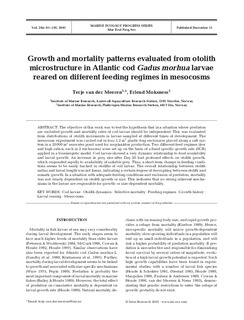Growth and mortality patterns evaluated from otolith microstructure in Atlantic cod Gadus morhua larvae reared on different feeding regimes in mesocosms
Journal article, Peer reviewed
Permanent lenke
http://hdl.handle.net/11250/108418Utgivelsesdato
2003-12-15Metadata
Vis full innførselSamlinger
- Articles [3009]
Originalversjon
http://dx.doi.org/10.3354/meps264095Sammendrag
The objective of this work was to test the hypothesis that in a situation where predators are excluded growth and mortality rates of cod larvae should be independent. This was evaluated
from distributions of otolith increments in larvae sampled at different times of development. The mesocosm experiment was carried out in four 5.2 m3 plastic-bag enclosures placed along a raft system in a 20000 m3 seawater pond used for zooplankton production. Two different feed regimes (low and high ration, each in 2 enclosures) were set up on the basis of a fixed specific growth rate (SGR) applied in a bioenergetic model. Cod larvae showed a very dynamic relationship to food availability and larval growth. An increase in prey size after Day 20 had profound effects on otolith growth, which responded rapidly to availability of suitable prey. Thus, a short-term change in feeding conditions seems to be easily tracked in otoliths of cod larvae. The overall relationship between otolith
radius and larval length was not linear, indicating a certain degree of decoupling between otolith and somatic growth. In a situation with adequate feeding conditions and exclusion of predators, mortality was not clearly dependent on otolith growth or size. This indicates that no strong inherent mechanisms in the larvae are responsible for growth- or size-dependent mortality.
Beskrivelse
Journal homepage: http://www.int-res.com/journals/meps/
